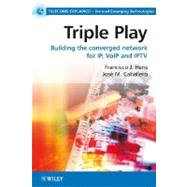
Triple Play Building the converged network for IP, VoIP and IPTV
by Hens, Francisco J.; Caballero, José; M.-

This Item Qualifies for Free Shipping!*
*Excludes marketplace orders.
Buy New
Rent Textbook
Rent Digital
Used Textbook
We're Sorry
Sold Out
How Marketplace Works:
- This item is offered by an independent seller and not shipped from our warehouse
- Item details like edition and cover design may differ from our description; see seller's comments before ordering.
- Sellers much confirm and ship within two business days; otherwise, the order will be cancelled and refunded.
- Marketplace purchases cannot be returned to eCampus.com. Contact the seller directly for inquiries; if no response within two days, contact customer service.
- Additional shipping costs apply to Marketplace purchases. Review shipping costs at checkout.
Summary
Author Biography
Francisco J. Hens is a senior technology specialist at Trends Communications Ltd. He holds a B.Eng. and an M.A. in Telecommunications from the Universitat Politècnica de Catalunya. Francisco has a wide experience in local and extended networks, and many of his interests include most of the technologies deployed in the field of triple play, voice, video and data applications: TCP/IP architecture and routing, Ethernet and Gigabit Ethernet, SDH, ATM, and DSL. He has published books, articles and white papers on these subjects.
José M. Caballero is the International Marketing manager for Trend Communications Ltd. He has an M.B.A., B.S. and an M.A. in computer communications. José has previously worked as a Communications Developer, Consultant at IBM, and is currently Director of Telecommunications in the UOC university. He is an acknowledged expert in next-generation networks and has published several articles, interviews and books on these subjects in the U.S., UK, Spain and Mexico. Over the last ten years José has given over 90 international lectures, seminars and conferences on Triple Play, NGN, SDH/SONET, 3G and Gigabit Ethernet.
Table of Contents
| Business Strategies | |
| Expanding Telco Businesses | |
| Triple Play Applications | |
| Driving factors of Triple Play | |
| Telcos Strategies | |
| Infrastructures | |
| Triple Play market | |
| Conclusions | |
| IP Telephony | |
| Coding of Voice Signals | |
| Network Performance Parameters | |
| Opinion Quality Rating | |
| Objective Quality Assessment | |
| Market Segments | |
| Audiovisual Services | |
| Digital Television | |
| Questioning the IPTV business models | |
| Regulatory framework | |
| Architectonic design | |
| Television and Video Services and Applications | |
| Format and Protocols | |
| MPEG Compression | |
| Service provision | |
| Contents | |
| Service assurance | |
| Signaling | |
| The Real-Time Transport Protocol | |
| The Real-Time Control Protocol | |
| The Session Initiation Protocol | |
| IP Multicasting | |
| IP Multicast Groups and Their Management | |
| Multicast Routing | |
| QoS in Packet Networks | |
| QoS Basics | |
| End-to-End Performance Parameters | |
| Marking | |
| The Triple Play Challenge | |
| Scheduling | |
| Congestion Avoidance | |
| Congestion Control and Recovery | |
| QoS Architectures | |
| QoS in ATM Networks | |
| QoS In IP Networks | |
| Broadband Access | |
| Broadband Services over Copper | |
| The Passive Optical Network | |
| Ethernet in the First Mile | |
| Contents | |
| Service Provisioning | |
| The Quadruple Play | |
| Cellular Communications Overview | |
| Wireless Communications Overview | |
| The IP Multimedia Subsystem | |
| Carrier-Class Ethernet | |
| Ethernet as a MAN / WAN Service | |
| End-to-End Ethernet | |
| Limitations of Bridged Networks | |
| Multi-Protocol Label Switching | |
| Migration | |
| Next Generation SDH/SONET | |
| Streaming Forces | |
| Legacy and Next Generation SDH | |
| The Next Generation Challenge | |
| Core Transport Services | |
| Generic Framing Procedure | |
| Concatenation | |
| Link Capacity Adjustment Scheme | |
| Conclusions | |
| Table of Contents provided by Publisher. All Rights Reserved. |
An electronic version of this book is available through VitalSource.
This book is viewable on PC, Mac, iPhone, iPad, iPod Touch, and most smartphones.
By purchasing, you will be able to view this book online, as well as download it, for the chosen number of days.
Digital License
You are licensing a digital product for a set duration. Durations are set forth in the product description, with "Lifetime" typically meaning five (5) years of online access and permanent download to a supported device. All licenses are non-transferable.
More details can be found here.
A downloadable version of this book is available through the eCampus Reader or compatible Adobe readers.
Applications are available on iOS, Android, PC, Mac, and Windows Mobile platforms.
Please view the compatibility matrix prior to purchase.